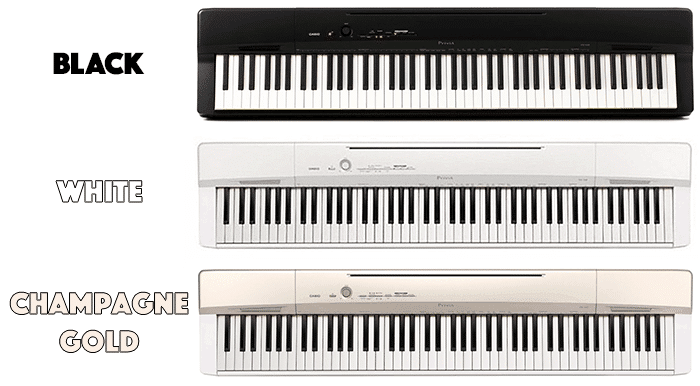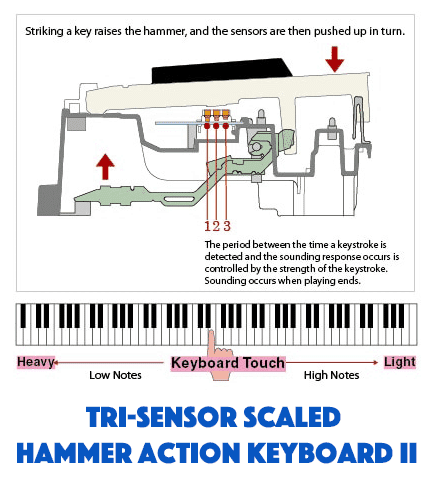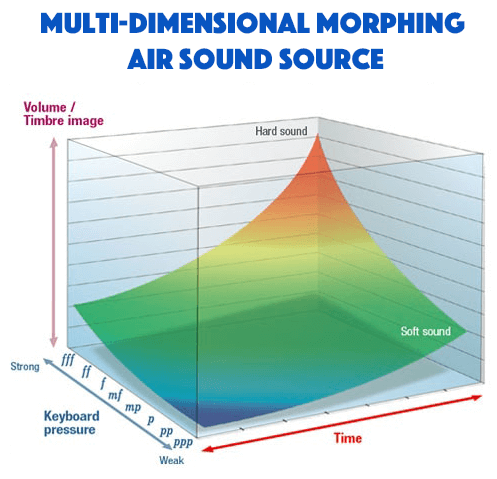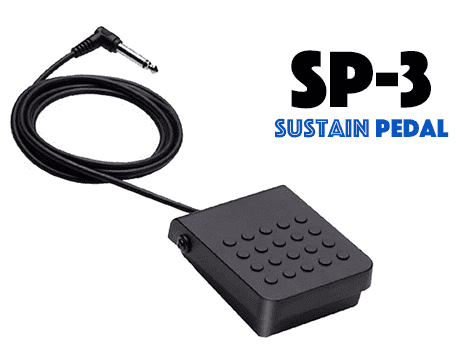Casio are well known for their extensive range of electronic products, amongst which includes digital pianos and keyboards. Throughout the years, Casio have established themselves amongst the leading developers and creators of digital pianos and keyboards.
Today we take a closer look at one of their products; the Casio PX160.
In this review we will take a close look at the PX-160 digital piano and we dive into its features, specifications, design, playability and our overall impression of the product.
Casio PX-160 Specs & Features
- Keyboard: 88 keys, Tri-sensor Scaled Hammer Action II, Touch Sensitivity (3 levels), Ebony and Ivory textured keys
- Tones: 128-voice polyphony, 18 built-in tones
- Key transpose: 2 octaves
- Speaker system: 2 in-built speakers (12cm x 2), 8W + 8W
- Dimensions: 52” x 11.5” x 5.5”
- Weight: 24.5 lbs (11.1 kg)
Design
The Casio PX-160 features a lightweight design with an improved speaker system from its predecessor, the Casio PX-150. The digital piano is quite light and weighs in at an astonishing 24.5 lbs (11.1kgs). This makes it a great option for the on-the-go pianist as the PX-160 is not strenuous to move around.
With that being said, it is nevertheless recommended that great care and diligence be taken when moving the piano as it is still a fragile product and mishandling could result in it being damaged.
The PX-160 has a width of 52” and this perfectly accommodates the 88 key Ebony and Ivory textured keyboard. The ebony and ivory textured keys provide a nice feel when played on and as opposed to some models, the keys feel more authentic to the user.
The Casio PX-160 comes on to the market as one of the slimmest digital pianos. Despite being a full 88-key digital piano, the PX-160 measures at 11.5” inches deep. This allows the pianist the flexibility of using the keyboard in small places and the slim nature of the digital piano also contributes to the light-weight attributes of the piano.
The Casio PX-160 is composed almost entirely of plastic. While this may sometimes be a downside to some digital pianos, there is no degradation to the quality of the PX-160 and as opposed to some other models this particular keyboard does not feel cheap at all. Not to mention the plastic housing adds to the light-weight nature of the piano.
However, one notes that plastic as a material can easily be damaged if dropped or knocked. It is therefore recommended that one purchases a travelling case so as to prevent any damage to the piano, especially if one intends to move around often with the device.
The light-weight Casio PX-160 comes available in three different colours: black, white and Champagne gold. The finish of the PX-160 stands out due to the modern colour grades used, and as such the pianos are not too ‘in-your-face’ nor are they unwarrantedly ostentatious. This allows the piano to blend into its surroundings while still catching the eyes of onlookers.
The Casio PX-160 features a simple and straightforward control panel that allows the user to quickly dive into using the instrument. There are dedicated buttons for the main piano sounds, metronome and recording features. There is a stand-alone power button as well as a volume knob, an improvement to having volume sliders.
However, despite the straightforward nature of the control panel it is worth noting that in order to access the rest of the sounds and functions, one must hold down the ‘Function’ button while simultaneously pressing labelled piano keys for the sounds/functions you want to access.
This however does not affect the overall design of the keyboard and it is hardly a problem because they keys contain labels. This makes it easy for the user to navigate and one does not have to cram or memorize certain combinations. All-in-all this allows the design to remain cluster free as the piano is not full of buttons and ultimately lends to its elegant design.
It is worth noting that unlike the Casio PX-770, the Casio PX-160 does not come with its own stand and users would have to acquire one. While this is not a design flaw, it is worth taking into account as the user will no doubt have to purchase a separate stand.
Keyboard
The Casio PX-160 has a fully weighted 88-key keyboard with ebony and ivory textured keys. The individual keys are the same size as that of ordinary acoustic piano keys, therefore they simulate the touch and feel of a real piano to a very accurate degree.
The realistic feel of the keyboard is no doubt thanks to the quality build and the inclusion of the ebony and ivory keys. The textured keyboard provides a comfortable feel when played and unlike many digital pianos, the keys do not feel like plastic despite the fact that they are indeed made from plastic. This is a simple yet important factor when purchasing a piano.
Like all Casio Privia models under $2000, the Casio PX-160 includes the Tri-Sensor Scaled Hammer Action II keyboard. This feature essentially provides the user with a very realistic piano feel when pressing down on the keys. This feature allows for greater dynamic range when playing the Casio PX-160 digital piano.
The realistic feel can be further attributed to the fact that the keyboard is fully weighted and thus it mimics the feel of a real acoustic piano. While many digital pianos use springs, the Casio PX-160 employs the use of actual hammers hence the realistic feeling when one presses down on any of the keys.
Acoustic pianos are known for being velocity sensitive. What this means is that depending on how hard and fast you play the keys, this affects the loudness of the sound. The triple sensor system of the Casio PX-160 allows for the piano to change volume depending on the velocity of each key press.
This feature brings you even closer to feeling like you are using an acoustic piano as the fully weighted keyboard mimics the action of hammers striking on the strings in an acoustic piano.
The Casio PX-160 digital piano comes with three different sensitivity settings and even has the option of allowing the user to turn off the sensitivity altogether. When the feature is switched off, each of the keys pressed will produce the same amount of volume regardless of how hard it is played.
The 3 sensitivity level pre-sets allow for greater dynamic range. Dynamic range in pianos is important as it provides the player with room for maximum expression in their compositions.
The Casio PX-160 comes with a graded keyboard. What this means is that when played, the PX-160 mimics the feel of a real acoustic piano whereby lower register keys feel heavy and as one gradually ascends up the keyboard the higher register keys feel lighter to the player.
Sound
The Casio PX-160 comes with 18 built-in instrument sounds:
- 4 electric pianos
- 5 grand pianos (Concert, modern, classic, mellow, bright)
- 5 organs
- 2 strings
- Bass
- Harpsichord
The five grand piano sounds of Casio PX-160 are high quality instrument sounds as the piano employs the use of real grand piano stereo samples. This means that the tone provided will be very close to that of a real acoustic piano and each of the five-different grand piano tones have a varying degree of timbre and dynamic range.
The Casio PX-160 allows for the user to fine-tune each tone to their preference by providing them with further options of sound effects including reverb and chorus.
The reverb effect comes with 4 pre-set settings: Stadium, large hall, small hall, room.
This allows for the user to plays notes that are more resonant as the reverb effect mimics the acoustic ambiance of different settings. The larger the setting, the greater the resonance of the key being played.
The chorus effect is available in 4-different pre-sets: Light, medium, deep and flanger.
Chorus essentially allows for the creation of a richer and more textured piano tone. In a nutshell, it recreates the effect of several sounds being played simultaneously. The flanger pre-set creates a whooshing effect.
Since the Casio PX-160 only allows for the user to record two tracks at a time, the piano’s 128-note polyphony is more than enough. The 128-note polyphony feature guarantees that the player will hear all the notes being played without notes being cut short. This allows for seamless playability and smoothness.
Casio’s world-renown Multi-Dimensional Morphing AiR (Acoustic and Intelligent Resonator) sound source is featured in the Casio PX-160. We note that there have been several improvements in the processor that will be discussed below.
One of the improvements is that the memory capacity of the processor has been increased threefold! What this means is that the user will be able to hear greater detail when playing as the processor has a higher quality sample rate. This brings you that much closer to a real acoustic piano tone.
Additionally, the improved processor system makes use of lossless audio compression. Simply put, the Morphing AiR Sound Source has the ability to reproduce sounds without any degradation, or distortion, to the quality. This leads to a more accurate sound as well as greater sound quality all round.
The Casio PX-160 has two in-built speakers that measure at 12 cm each. These are powered by two 8 W amplifiers. In comparison to the PX-150, these speakers provide a much better sound quality as they are clearer and allow for greater attention to detail.
The speakers are powerful enough for intimate performances but the piano will ultimately need to be connected to an amplifier/PA system for larger performances so that the piano is not over-powered and drowned out by other instruments.
Features
Modes
The Casio PX-160 comes with several modes that can be accessed. One of these is the Split Mode feature. This essentially splits the keyboard into two parts whereby the left-hand side will feature one sound/instrument, and the right-hand side will feature a different sound/instrument as well.
However, worth taking into account is the fact that the left-hand side of the keyboard can only be used as a bass sound. As such, when the bass sound is selected, the PX-160 automatically splits itself into two separate parts whereby the bass is, essentially, permanently assigned to the left-hand side.
While this isn’t a new or revolutionary feature to the Privia line, it is nevertheless one that will no doubt come in handy as two people can play side-by-side with varying sounds. This means that two people can jam out without having to worry about additional instruments, for the win!
Up next, the Casio PX-160 features the additional Layer Mode setting. As the name suggests, this allows for the user to combine two varying sounds and play them at the same time. The mode is simple and straightforward to use and merely requires for the player to select the two sounds they want to layer, and they will sound when a key is played.
This feature allows for the user to create new interesting sounds when they’re playing. For instance, the player has the option of layering a grand piano sound along with one of the string instrument options.
Finally, the last mode included is the Duo Mode feature that comes with the Casio PX-160.
Also referred to as duet mode, this splits the keyboard into two equal parts with the same pitch ranges. This allows for two players to play with each other side-by-side without having to use an additional keyboard.
This feature makes it easy for the user to teach another player how to play piano. It also makes it an interesting and very versatile tool during practice/jam sessions as it allows for easy and seamless musical collaboration between the players.
This feature is included in some of the other Privia models including the PX-770 but it is a brilliant addition to the Casio PX-160 as it opens doors to a world of possibility. Not to mention that it goes towards justifying the price tag that comes along with this versatile digital piano.
Transposing, Octave Shifting & Tuning
Digital pianos have traditionally hosted a variety of features of which one of them is the ability to shift the pitch of the piano. This simple yet essentially feature is an industry standard and allows for piano players to match vary keys of other instruments being played alongside the piano.
The transpose feature is straightforward and allows for the user to either lower or raise the pitch of the keyboard. This is done by way of shifting the pitch through semi-tone steps. This allows for the piano player to get the exact key they want without having to struggle.
The Octave Shift feature, also known as Pitch Shifting, simply allows for the user to raise or lower the original pitch of a sound by octave units. This allows for the user to have greater flexibility when playing the Casio PX-160.
Furthermore, the Casio PX-160 features a fine-tuning function at allows for the user to meticulously tune the pitch of the piano. This feature gives the possibility of being able to tune the entire keyboard by raising or lowering its pitch in 0.1hz steps. Whereas the standard keyboard has a pitch of A4 = 440 Hz, the user can manipulate this to their preference.
While these features are not game changing, they are an absolute necessity when it comes to digital pianos and Casio do not disappoint when it comes to this.
Recording and Playback
The recording and playback function of the PX-160 provides the user with all their needs in terms of being able to create and record musical compositions.
The Casio PX-160 allows for the user to record their performances by way of multi-track MIDI recording. The MIDI recording functionality allows for the player to record up to two tracks at the same time. This simple feature allows for the user to compose interesting songs with varying sounds to keep the listener entertained.
The PX-160 allows for the user to play both sounds simultaneously and also provides the option of turning off one track so that they play individually rather than at the same time.
For the modern-day musician, the MIDI function is an absolute necessity, especially for music producers/composer. This function allows for direct recording from the piano straight to your Digital Audio Workstation where the MIDI recording can be edited, manipulated and further refined. A big win!
However, take into account that the piano only has the capability to record one song. Therefore, the recording of a new song will result in previously recorded data being deleted from the memory.
The MIDI recording function of the Casio PX-160 compensates for the fact that the user cannot actually record the audio being produced by the piano.
Metronome
Keeping in the right tempo has never been easier with the inclusion of a metronome feature on the Casio PX-160.
For those not familiar, a metronome is a tool that allows for the player to set a specific tempo (BPM) that they want to follow. The metronome then produces a basic click track that the user can follow so that they remain in tempo. User has the option of adjusting the volume of the metronome.
The metronome function on the PX-160 is not a game changer, but it saves the user any further expense of having to buy an external metronome. While these may not be pricey, the in-built feature is accurate, simple and straightforward to use for beginners and seasoned musicians alike.
Connectivity
The Casio PX-160 comes loaded with a variety of versatile connection options that allow the player to use the digital piano in conjunction with several different devices.
Firstly, the Casio PX-160 comes with two in-built mini headphone jacks (3.5mm). These allow for two sets of headphones to be used at the same time. This may be particularly advantageous for players using the Duo Mode function as they can both listen in without having to share one set of earphones/headphones.
This is also handy as it allows for two users to play the piano side-by-side in a discrete manner. With this in mind, you don’t have to worry about waking up the neighbours during your late-night jam session.
The Casio PX-160 also includes a type B USB port that allows for the piano to be connected to a computer. This function will allow for musicians to seamlessly connect to their preferred audio software where they can record, edit and craft new sounds thanks to the MIDI-functionality of the keyboard.
The piano can also be used as a MIDI-controller thanks to the USB connectivity option. This means that the piano can also double as a drum machine without the need of acquiring any further MIDI-controllers.
Furthermore, one does not need to download or install any additional drivers so as to use the piano in conjunction with their computer. Regardless of which operating system you’re using, whether Mac or Windows, the Casio PX-160 is truly plug-and-play due to its ease of use.
However, the PX-160 does not come with a USB cable and this will need to be purchased separately. These are usually in-expensive therefore this should not serve as a stumbling block.
The Casio PX-160 also includes a Line Out R, L/Mono connection option. This allows for the seamless connection to external sound devices such as amplifiers, PA systems and even mixer boards.
Accessories
The Casio PX-160 comes with several included accessories:
- Music rest
- Sustain Footswitch (SP-3)
- Owner’s manual
- AC Power Adapter
Sustain Pedal
The Casio PX-160 comes with the Casio SP-3 sustain pedal.
A sustain pedal is amongst the most commonly used pedal in modern pianos. This essentially allows for a player to keep a note or chord sounding while they play. This allows for a richer sound and more dynamic playing tone.
While this is a welcome addition seeing as you won’t have to purchase an external device, it is worth noting that the pedal does not feel anywhere remotely realistic. The sustain pedal is made of plastic and this is easy to tell simply by the look of it.
As result, more seasoned players may prefer to buy a separate sustain pedal that feels closer to that of a real acoustic piano.
While this is not a deal breaker, it is something worth noting as ultimately one would have to spend more money replacing it with something more realistic.
Other Accessories
The Casio PX-160 comes with an AC Power Adapter cable. While this may seem like a no-brainer, some digital piano makers require for this to be purchased separately. While it may not cost much financially, the main issue arises when one purchases a generic power cable which may ultimately lead to damage of the piano.
The owner’s manual allows for the user to quickly check on any issues that may arise and also allows for them to fully learn about their device from top to bottom.
Unlike some Privia models such as the Casio PX-770, the PX-160 does not come with a piano stand. What this means is that one would have to purchase this separately. However, the Casio PX-160 is such a lightweight piano that it could easily be placed on a desk without the user needing to purchase a stand.
The Casio PX-160 does not come with a travel bag/case. It is recommended that one purchases this if they intend on moving around the keyboard frequently. While the plastic housing of the piano is sturdy, it may nevertheless take unwarranted damage if knocked or dropped.
Summary
Pros
- The Casio PX-160 offers unbeatable quality for an instrument within its price range. For an entry-level digital piano, it adequately addresses the needs of the player by providing them with all the tools and functions they require.
- The Casio PX-160 is an extremely portable device due to its light-weight nature. The piano can be easily transported without much fuss or effort. This is the perfect 88-key digital piano for the on-the-go musician.
- Despite its low-price tag, the Casio PX-160 does a fantastic job of mimicking an acoustic piano as the fully-weighted ebony and ivory keytops provide for a very authentic feel. This is a perfect device for those looking to transition into using acoustic pianos in the future.
- Despite the few instruments, tones and effects available, the Casio PX-160 compensates for this by ensuring that all the sound samples included in the device are of high-quality!
- With ample connectivity options, the Casio PX-160 suits the night-owl musician, the on the-go piano teacher and the constantly-working music producer.
Cons
- The Casio PX-160 comes with a sustain pedal that feels very amateur and plastic. This is no surprise as the pedal itself is made almost entirely of plastic! Ultimately, one would replace this with a pedal that feels truer to that of an acoustic piano. As such, this is a financial outlay one should bear in mind.
- The PX-160 does not allow for audio recording and playback. This means the user cannot actually record the sound of instruments being played and they would have to use external connectivity to achieve this. This may prove to be a tedious prospect.
- The many buttons give the keyboard a cluttered appearance. A digital display system would be far better and would allow for a sleeker and more elegantlook to the PX-160
- Without the inclusion of a stand, one would have to purchase this separately. While these may be inexpensive, finding a good quality stand will set you back slightly financially.
Summary
Final Verdict
- Playability: 7/10
- Ease of Use: 6/10
- Value for Money: 9/10
- Features: 5/10
- Sound Quality: 7/10
- Design: 5/10
Total score: 8.2/10
Alternatives
Casio PX-770 (full review)
A newer addition to the Privia line, the Casio PX-770 utilises all the features of the PX-160 in a new stunning upgraded design. With in-built pedals and a stand, the player saves a considerable amount of money as they do not have to purchase these separately. The PX-770 also comes with more instruments.
However, this model is $200 more expensive than the Casio PX-160 and this may prove to be a put-off for the budget musician who does not wish to break the bank for a digital piano.
Yamaha P-115
While this product is from a different manufacturer, it gives the Casio PX-160 a close run for its money. The Yamaha P-115 features 192-note polyphone, just like the Casio PX-160. It has been lauded for its very realistic grand piano sound. There are no major differences as the Yamaha P-115 also features a two-tack midi recorder as well as varying modes.
The Yamaha P-115 retails for about $100 more than the Casio PX-160 and given the major similarities between the features of the two pianos, it is very easy to argue that the Casio PX-160 is a most cost-effective purchase.









